“So, what are you going to do with your life?”
I found myself running away from properly answering this question for most of my adult life…
I find it funny because as a kid, I used to always ponder the answer to the question “What are you gonna do when you grow up?”. Back then, I used to have so many answers and couldn’t wait to see them any of them come true.
Today, I am going to share with you how I found the answer to this life question as an adult.
In the last two weeks, we’ve covered the methods to positively change What We Do and How We Live. This week, let’s address the Why.
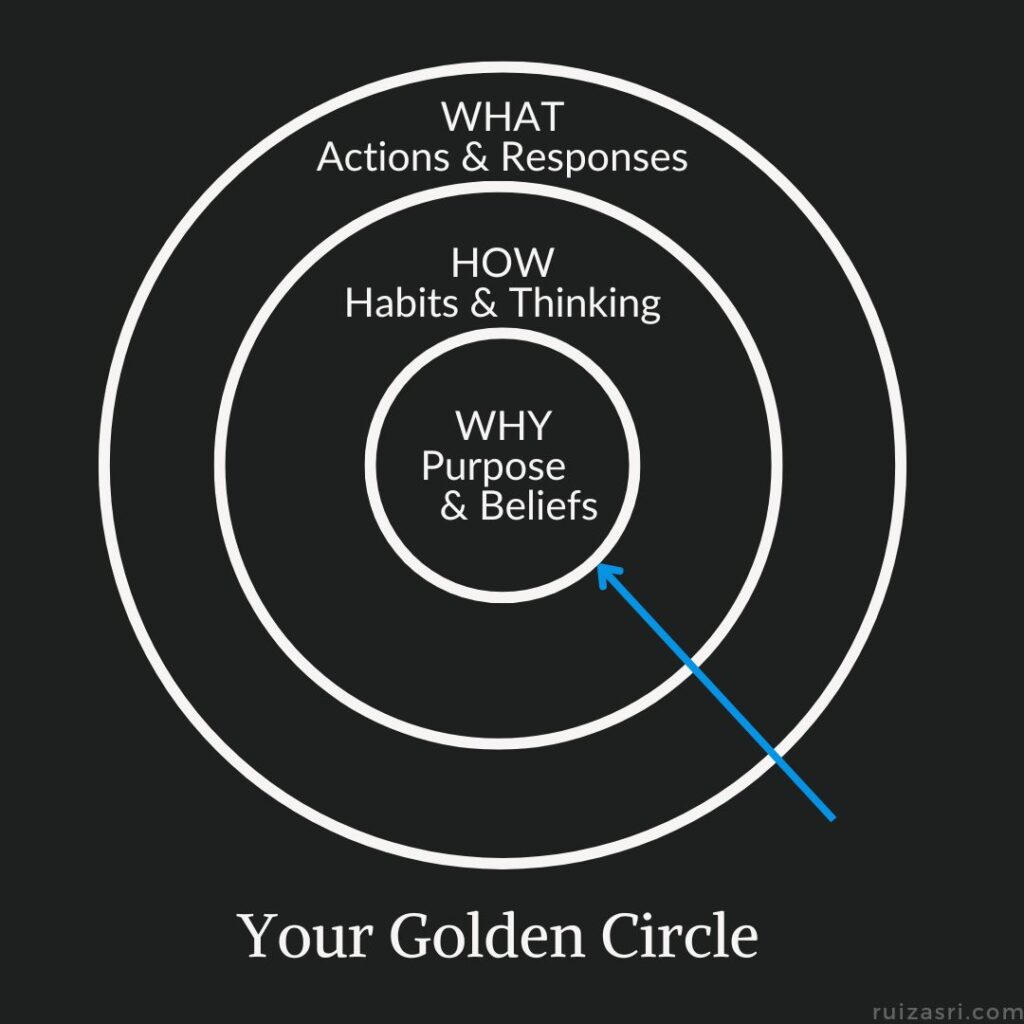
Being at core our Golden Circles, the Whys (Purpose and Beliefs) are important because it drives all our Whats and Hows.
- But how do your clearly figure out your Purpose and Beliefs?
- And once you know them, how do you properly use them to better your life?
The comprehensive answers to these two questions lies in creating your a life strategy.
Strategy 101
First, we need to realise that a strategy is not a plan.
A plan is a “checklist of tasks for you to complete, in some kind of order and time limit”.
The 12-Week Grind system that we covered last week helps you create a plan. But the system does not help you create a strategy.
A strategy is an integrative set of choices that positions you to win on a playing field of your choice, as explained by Prof. Roger Martin.
In other words, you form a strategy by making up your own rules and your own win conditions in a way that you come up victorious.
You play your own game, not another person’s game.
In the corporate world, all businesses can agree that a clear and coherent strategy is vital for the organisation to prosper in the future.
Without a strategy, any business is doomed to fail.
Similarly, any life without a strategy is doomed to be unfulfilling.
As Seneca said,
“If a man knows not to which port he sails, no wind is favourable”.
If you don’t know what it personally means to ‘win in life’, then nothing you plan or do will ever help you be successful.
From Corporate Strategy to Life Strategy
Enter the art of Corporate Strategy.
Business professionals have long acknowledged the criticality of having a comprehensive strategy for a business to be successful in the long run. Hence, many of them have devised structured frameworks which take a step-by-step approach to answer this loaded but critical question:
“What should we do for the future of the organisation?”.
In most Corporate Strategy frameworks, they require the company to devise clear answers to these 7 questions:
- How does the organisation define success?
- What is our purpose?
- What is our vision?
- How do we assess our business portfolio?
- What can we learn from benchmarks?
- What portfolio choices can we make?
- How can we ensure a successful, sustained change?
Lucky for you, this framework can be adapted to our personal life, and help you strategise your life.
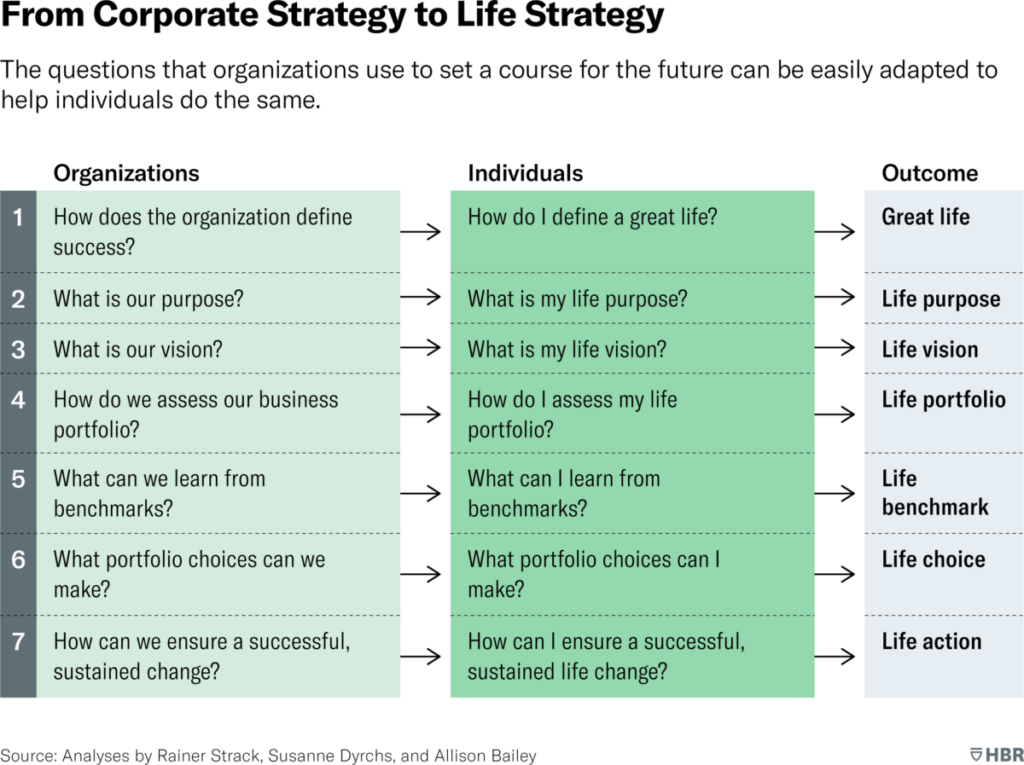
Harvard Business Review (HBR) has an in-depth article that discusses the intricacies of adapting a corporate strategy framework into devising your own life strategy. HBR’s step-by-step guide even includes a worksheet to create your own life strategy.
But here are the main takeaways and also how I practically use it:
How to: Strategise Your Life
A Life Portfolio is what you will end up building for yourself once you complete the Strategise Your Life exercise.
The Life Portfolio will make it clear to you what are your:
- Beliefs: How do you define a great life?
- Purpose: The culmination of what you’re good at, what you find important and what you’re passionate about.
- Strategic Life Unit Matrix: A chart that shows the state of your Key Areas of Life in terms of their importance, satisfaction and time spent on each one.
- Next Steps: Once you’re clear on the above, you will know which areas of life require improvement which you can then take action using the 12-Week Grind system.
Here’s my life portfolio that I made last year as an example:
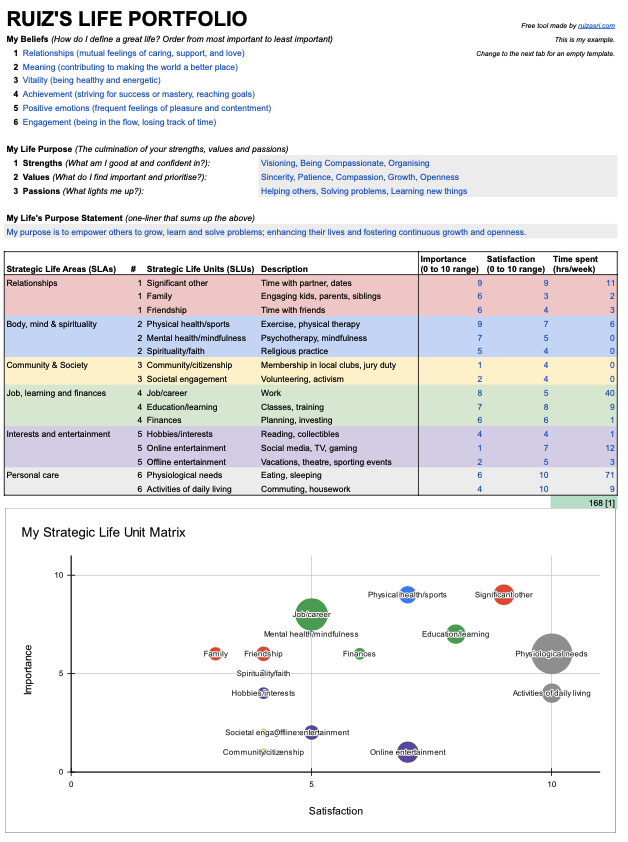
By the end of this newsletter, you will be able to make your own life portfolio. I have made a Life Portfolio Template that you can use for free.
So, let’s break it down step-by-step.
Your Beliefs
‘Beliefs’ from a life-design perspective are the things that you feel are important in life.
They are the things that if you’ve managed to fulfil by the time you reach your deathbed, you would say, “I’ve lived a good life”.
Many psychological wellbeing studies have tried to model the shared Beliefs that most people hold. The PERMA-V model by Dr Martin Seligman is the one I use. It includes the following factors:
- Positive emotions (frequent feelings of pleasure and contentment),
- Engagement (being in the flow, losing track of time),
- Relationships (mutual feelings of caring, support, and love),
- Meaning (contributing to making the world a better place),
- Achievement (striving for success or mastery, reaching goals),
- Vitality (being healthy and energetic).
ACTION:
- What you want to do here is assess the 6 factors above, and order them from what feels most important to you to the least important. These make up your beliefs.
As an example, my top 3 are Relationships, Meaning and Vitality.
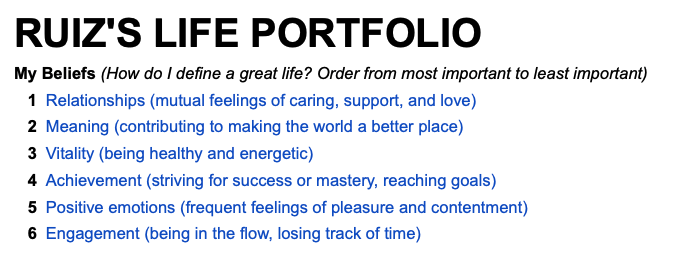
If I can maintain a great relationship with my loved ones, build a career that helps other people, and continue to be healthy, I would consider that I have won in life.
Even if it means that I have not achieved as much in running a business that makes a lot of money and sacrificing doing fun activities like travelling and playing games, I believe that my life would be meaningful.
Your Purpose
“What is your life’s purpose?”
This is really a loaded question… but what is the point of answering it?
By defining your life’s purpose, you define the playing field that you should be in the first place. You draw the boundaries and rules of the game that you play.
By knowing your ‘Purpose’, you can better position yourself to fulfil your win conditions (‘Beliefs’) and ultimately come out victorious.
There are many ways to approach answering this question, but HBR has a structured solution which I’ve found useful.
Your life purpose is the overlapping result of 3 things:
- What you’re good at (Strengths),
- What you find important (Values) and,
- What lights you up (Passion).
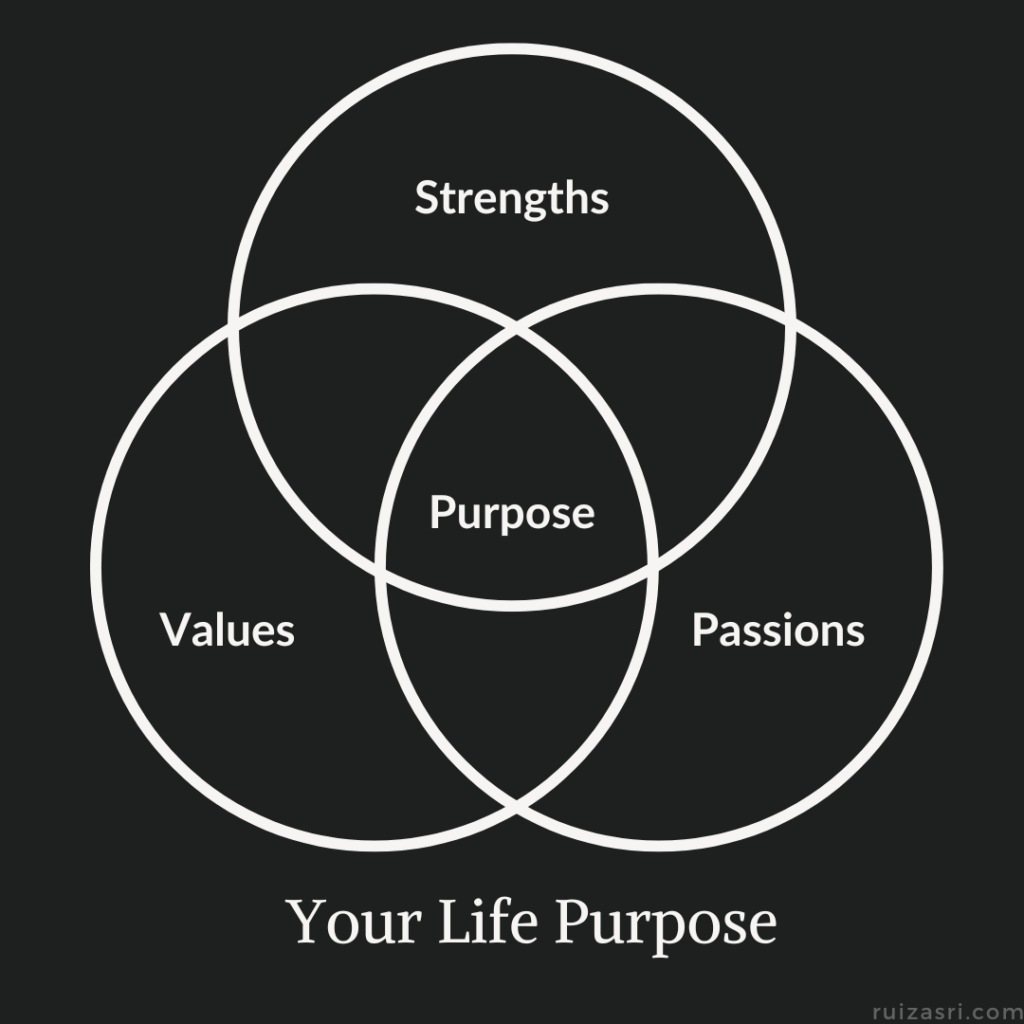
This requires a bit of introspection, but they should be quite clear to you when you approach each question individually.
To give your life purpose crystal clarity, it is best to write it out as a purpose statement.
ACTION:
- Answer the 3 questions above separately and write down the answers.
- Then, combine those separate answers to form your purpose statement.
- If you’re not sure how to form your purpose statement, you can use this Chat GPT-4 prompt.
For me, this was the life purpose statement I came up with:
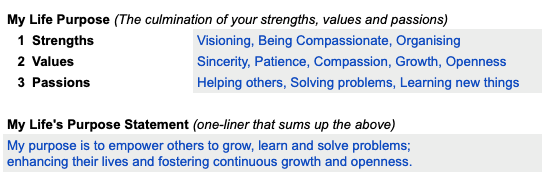
This is my current life purpose, and also the main reason why I decided to commit to writing these actionable weekly newsletters. 🤓
Strategic Life Unit Matrix
In any corporate strategy, companies would have certain business units which act as parameters in their portfolio. The business units act as a guide for the company to decide on what areas they should invest more resources in.
For a life portfolio, there are 6 strategic life areas (SLAs) which can be broken down into 16 strategic life units (SLUs).
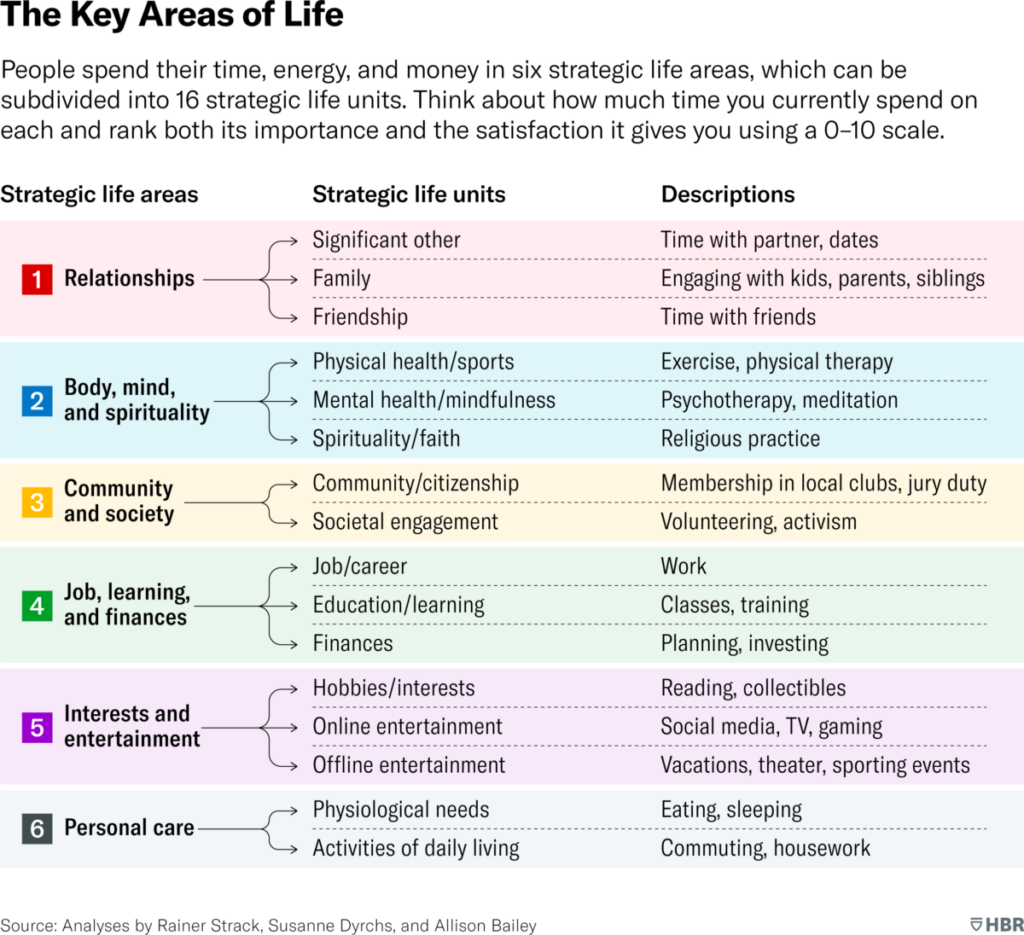
Think of these SLAs and SLUs as elements within a person’s life that they invest their time and energy in.
For every different individual, they would assign to each SLU a different:
- Importance level: How important is this SLU to you?
- Satisfaction level: How happy are you with the state of this SLU in your life?
- Time spent: How much time do you actually spend on this SLU?
Once you’ve answered all the above for each SLU, then you would have completed your SLU Matrix.
This was the SLU Matrix I had made:
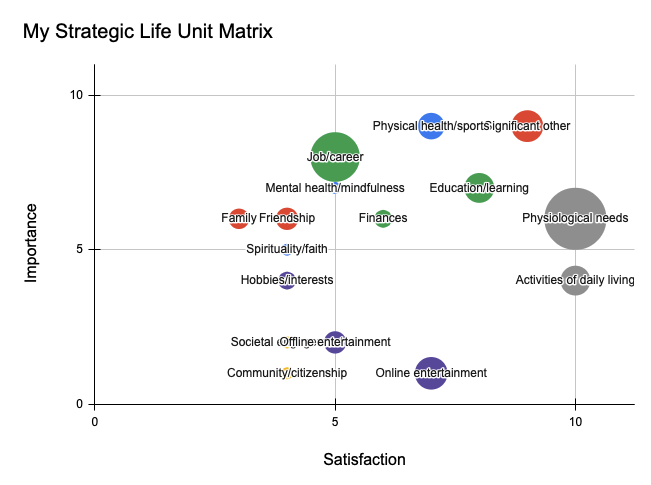
Once you’ve filled out your SLU Matrix, the important action here is to analyse our own data so that we can extract actionable insights.
Note that:
- The more to-the-right an SLU is located, the more satisfied I am with it.
- The more to-the-top an SLU is located, the more important it is to me.
- The bigger the circle of the SLU, the more time spent on it.
If you look at my SLU Matrix, there’s a few things you can infer:
- Top Right Quadrant:
The 3 SLUs (Physical health, Significant other, and Education) are important to me, I am quite satisfied with all of them and I am spending decent time on them. Great.
- Top Left Quadrant:
My relationship with my Family and Friends are quite important to me, but I am not very satisfied with them and nor am I spending enough time on these. Perhaps I can dedicate more time to improve these.
- Bottom Right Quadrant:
While I am satisfied with my Online Entertainment (playing games and doomscrolling social media), this SLU is actually not that important to me. Maybe I can reduce the time I spend on them and use it for something more important.
From the above inferences, I know that the areas of my life I should improve on are my relationships with my family and friends. If time is an issue, perhaps it’s a matter of reusing the time I use for playing games and social media.
There are other insights that can be extracted from my SLU Matrix above, but the point here is that the matrix acts as a practical visual tool for you to assess your life from a strategic POV.
ACTION:
For each SLU, think about and answer the following:
- How much time do you actually spend on this SLU per week?
- How important is this SLU to you?
- How happy are you with the state of this SLU in your life?
Once you’re done, look at your own data and find out:
- What are areas that you’re ‘winning’ in?
- What are areas you find important but are not satisfied with?
- What are areas you don’t find important but are spending too much time on?
- Which areas can you reduce time on so that you can reallocate to more important areas?
Next Steps
Done the above?
Congratulations! You’ve built your own Life Portfolio.
With your Life Portfolio, you have now figured out your Purpose and Beliefs (Why you live).
- You can definitively say what ‘winning in life’ means personally to you.
- And you also know your life’s purpose so that you can come out victorious at the end of it.
- You also have the SLU Matrix, a handy tool that you can use to find out what is lacking and where you can improve in your life.
Your next steps?
Implement those changes through how you live.
With that, you’ve now read through my entire 3-part life-design series:
- What we do (Actions & Responses)
- How we live (Habits & Thinking)
- Why we live (Purpose & Beliefs)
I hope you’ve found actionable value from my life-design newsletters.
I have spent a lot of time writing about this because I have genuinely found these concepts and methodologies helpful. They have helped me figure out my own purpose in life and given me clarity in terms of how I should live my life.
Many people would find such life-design exercises troublesome to do as they require a lot of time and emotional energy. But for me, they have certainly been worth it.
I now have a wholehearted answer to the question:
“So, what are you going to do with your life?”
I now invite you to build your own life strategy. You can use this template:
Thanks for reading my newsletter today.
Oh yea, happy new year!
Till next week,
Ruiz
